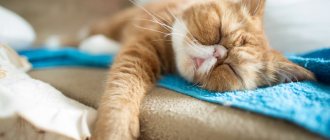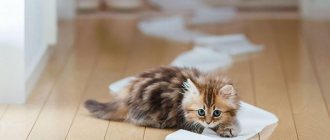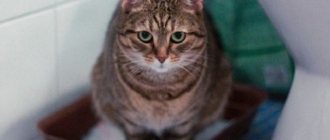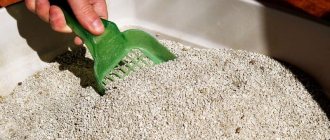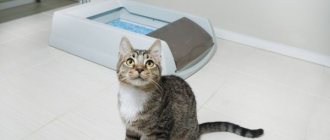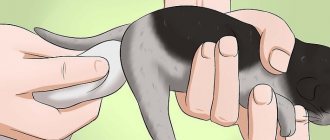Often cats suddenly develop health problems, and the owner does not know what to do or how to help the pet. If the cat cannot go to the toilet in a small way, then, of course, you need to quickly contact a veterinarian. In our article we will try to explain in more detail the problems of this disease, what the causes of this condition may be, and how to provide all possible help to your pet.
How to tell if your pet has urinary problems
If a cat cannot go to the toilet in a small way, then it will be difficult not to notice, because she moans loudly, meows, and screams in a voice that is not her own. When she does manage to urinate, very little urine comes out. The pet can come up to its tray, stomp next to it, and snuggle up to it. It’s as if he doesn’t dare to go into it; in fact, the cat is trying to help himself go to the toilet to urinate. He does not allow you to touch his bloated belly, like a drum, which is very painful. The pet cannot lie on its tummy. Sometimes there are traces of pus or blood in the tray.
What does "little" mean?
Of course, all this is subjective and directly depends on physiology, habits, the amount and type of food consumed, and even the size and age of the animal, but there are still certain “norms,” if you can call them that. On average, a cat should walk “smallly” at least once a day. Of course, she can do this more often. Visiting the litter box once every two days is also possible, but this is not very normal and can already become a signal of deviations in the health and general condition of the pet.
It is also worth considering that an animal of average weight (3.5-5 kg) on average leaves about 120 grams of liquid in the tray every day, so if the cat runs to the toilet often, but with virtually no results, it’s time to start worrying.
What can cause such a condition?
Many owners of mustaches are interested in why problems with urination occur? Your pet rarely goes to the toilet for several reasons:
- Low urine output can be caused by insufficient fluid intake. A small amount of urine contains a high concentration of salts, from which stones subsequently form.
- Hereditary factor. If a cat has had similar diseases in its family, then it is more likely to have problems with urination than those animals whose heredity is not burdened with such issues.
- Physiological features. There are cases when a kitten is born with a urinary tract obstruction. This issue can only be resolved surgically.
- Improperly managed cat nutrition can lead to heavy urination. Excessive consumption of raw meat and fish, salty and mineral foods can provoke this problem.
- A cat may rarely go to the toilet if he is overweight. As a rule, such pets lead a sedentary lifestyle, which can cause poor urine flow.
- This reaction occurs after suffering stress. This could be a sudden move, a change of owner, or a trip on public transport.
There is an opinion that cats that eat dry food are more likely to develop urolithiasis. However, this is a misconception; on the contrary, dry food is a more balanced source, the main thing is that the cat always has fresh water available.
Cats Lack of urination vetna
Unfortunately, cats quite often suffer from diseases of the genitourinary system. These animals are more susceptible to such diseases than other pets. Most often, this disease manifests itself in the fact that the cat begins to spin around the tray for a long time, meow, sit in and out of it. Urination may be intermittent and uneven. Such a situation requires immediate intervention from not only the owner, but also the veterinarian.
Causes
Lack of urination in cats can be caused by a variety of factors. It is worth noting that such problems more often occur in cats, not cats. This is due to anatomical features. The most likely causes: - The presence of sand, mucus, salts and stones in the canals of the urinary system. In this case, droplets of blood may be visible in the urine. If the disease is left unattended, the channels can become completely clogged; — Impaired kidney function. It is usually accompanied by loss of appetite, dehydration, severe exhaustion, and in some cases vomiting may be present. If the animal has kidney disease, the discharge will be cloudy in color; - Stress. In fact, cats are very sensitive creatures. Urinary retention can be caused by stress. If this is the reason, the animal must be given sedatives; - Infectious diseases. Bacteria and viruses can lead to many disorders in the body. The cat may urinate blood. It is worth noting that such deviations can be caused even by a common cold or simple hypothermia; — Impaired contraction of the bladder walls. This is usually the result of various injuries; “Tumors can also lead to such failures, but this happens in very rare cases.
Symptoms
How can you tell if your pet is in trouble? In most cases, diseases of the urinary system are quite noticeable; they can be identified by the following signs:
- The cat may start running to the litter box very often, but the discharge will be very insignificant; — Salt crystals, droplets of blood, and sometimes even tiny pebbles may be present in the urine; - The animal may not go to the toilet at all; - Touch your cat’s belly; the bladder will be very hard to the touch; finding it will not be difficult; - The cat can constantly spin around the tray, it will be clear that the animal is experiencing not only discomfort, but also pain; — On the second or third day, the pet will be very lethargic and apathetic.
The presence of at least one of these points indicates that not everything is in order with your pet’s body. It is almost impossible to independently determine what exactly the problem may be. To avoid possible serious complications, contact your veterinarian as soon as possible. Only after examination and tests will he be able to advise you on something specific. It is worth noting that the absence of urination for three days can lead to death, the probability of this is very high.
Treatment
The veterinarian will tell you exactly what the treatment will be only after a direct examination. In most cases, drugs are prescribed individually. This depends on the severity of the disease and the condition of the animal itself. In order to ensure temporary outflow of urine, the veterinarian will make a puncture in the abdominal wall. Usually, after the first procedures, the cat is given a special drug that eliminates dehydration and removes toxins from the body. Antibacterial medications are also often prescribed. If your cat has had urinary problems in the past, surgery may be necessary. To prevent a repeat of the situation, it will be necessary to expand the urinary canal. To ensure that complications do not arise again, be sure to follow all the doctor’s recommendations. Particular attention should be paid to dividing the food; the general condition of the body depends on it. For preventive purposes, a couple of times a year the cat can be given various vitamins and specially designed diuretics; they help eliminate the stones located inside. Always look closely at your pet, pay close attention to its behavior. In case of urinary retention, visit a specialist as soon as possible. Prompt treatment can save your cat's life.
What can be done to alleviate the pet's condition?
Of course, when a cat cannot urinate, it is necessary to urgently take him to the veterinarian, but if this is not possible, then you can put a heating pad on the pet’s perineum and stomach.
Under no circumstances should you massage your cat’s tummy; these actions can only worsen your pet’s condition.
First and urgent aid is to insert a catheter to drain urine. This is a difficult and rather painful procedure and should only be carried out by a qualified specialist, and there are often cases of placing a catheter under general anesthesia. During catheterization, the bladder is washed with antiseptics. Frequent catheterization should not be performed because this procedure leads to swelling of the urinary tract, and as a result, the cat will not be able to urinate. Next, the veterinarian will determine the cause of this condition and prescribe treatment.
Diagnostics
After emergency measures are taken, the cat must undergo the necessary diagnostic procedures to identify an accurate diagnosis and prescribe the necessary treatment. Typically, a urine test is taken from the animal and an ultrasound scan of the abdominal organs, kidneys and bladder is performed.
Where to go for help
You can call us at the veterinary office. We employ experienced specialists who are well versed in their field, and they will definitely help your pet. Our own laboratory allows us to obtain examination data within an hour, and modern equipment makes it possible to carry out complex emergency operations. With our surgeon, your cat is in good hands. Come, call or leave requests on the website - we won’t leave you in trouble!
POLAR BEAR
The veterinary clinic in Nizhny Novgorod "White Bear" provides all types of services for cats and dogs.
Conducts any examinations and tests in its own veterinary laboratory; the clinic operates a veterinary ambulance for animals and a 24-hour veterinarian is on call at home. Agreement on the processing of personal data
Public offer
SITE MENU
- About the clinic
- Price list for veterinary clinic services
- Treatment
- Services
- Price list for veterinary clinic services
- Vetapteka
- Contacts
- Site Map
CONTACTS
- Nizhny Novgorod st. Vyatskaya 7
- 8 (831) 437-25-27
- [email protected]
Treatment
If a cat does not walk for several days or does so rarely, then a large number of microorganisms multiply in his bladder. At first, the cat should be in a hospital so that stagnant urine can be professionally removed. Using injections, fluid is administered to the pet to eliminate dehydration. The veterinarian also prescribes antispasmodic drugs to help relieve pain and relax the urethra. Antibiotics and antibacterial agents are usually used to help relieve inflammation in the bladder. After treatment, the cat is discharged home, where all care falls on the owner.
Corrective diet
If a cat is susceptible to urolithiasis, then it needs a corrective diet. It is necessary that the food be rich in vitamins B6, A and glutamic acid. Food should not contain salt and minerals, namely:
- The cat should have a complete exclusion of salty foods.
- Raw fish and meat are prohibited.
- The consumption of all types of fish is excluded. Phosphorus, found in any type of fish, is deposited as an excess mineral in the bladder and leads to the formation of stones.
- Milk should not be consumed by a pet with urinary problems. The point is the increased magnesium content, which will lead to even worse urine flow.
- Pork is too fatty meat, it will lead to thickening of urine, which will further complicate its outflow from the bladder.
The cat should eat special dry food, balanced for animals with problems in the genitourinary system.
Risk categories
Problems with urination often occur in cats that have undergone castration as children. There are cases when urinary retention occurs in kittens, but according to statistics, adults most often suffer from this condition, especially in cats. If a newborn kitten has a problem with urine discharge, then the reason, as a rule, lies in congenital mechanical obstruction of the urinary tract.
How much water should cats get?
When cats eat raw meat, a sufficient amount of water enters the urinary system. Water flushes out minerals and crystals, keeping your bladder and urethra healthy. True, a small amount of crystals in the urine of any species is normal. If the body receives water in the required quantities, minerals and crystals are regularly eliminated, which prevents the formation of stones in the urinary tract.
Common prey for cats in the wild are mice, lizards or small birds. They consist of approximately 75% water. The average water content of dry food is 8%. Cats that eat dry food drink more water than those that eat meat. But if you add up the fluid intake from all sources, that is, from food and directly from drinking water, it turns out that cats that eat dry food receive much less water than cats that eat raw meat or canned food. Cats on a dry diet are more or less in a constant state of dehydration.
Preventive measures
It is quite difficult to cure the reason why a cat cannot urinate; out of 10 cases there will be 9 obligatory relapses. To alleviate your pet’s condition, preventive measures are important:
- Avoid overcooling your cat. The pet should not lie in a damp place, on concrete; if he wants to soak up the sun, it is better to do this on a warm blanket.
- Timely vaccination will lead to fewer diseases, which means fewer microorganisms will enter the cat’s body.
- A well-designed diet for an animal helps to avoid recurrences of inflammatory conditions in the animal’s genitourinary function. It is necessary to completely exclude all prohibited foods. Even once using a prohibited product can cause a relapse.
- Drinking plenty of fluids helps flush out your pet's bladder. Moreover, the water must be fresh and clean, and always be freely available to the animal.
- There is a special dry food available for sale for cats with disorders of the genitourinary system.
Unfortunately, it is impossible to completely cure urolithiasis in a cat. A caring owner should surround the pet with attention, regular preventive examinations, constant use of medications and a balanced diet. Such measures will help the cat lead a normal life.
What to do?
If urinary dysfunction is definitely caused by stress, you should try to minimize it by giving your pet more attention and support, which is no less important for a cat than for a person.
If the cat does not like the new tray or filler, you need to return to the proven model of the tray and granules with the usual texture.
In all other cases, when the presence of a disease is evident, it is best not to try to self-medicate and contact a veterinarian as soon as possible to establish an accurate diagnosis and select the appropriate treatment.
Why does a cat pee a little?
A cat should pee, if it is already a year old, about 2 times a day. If urination does not occur for several days or a very small amount of urine is found in the tray, this indicates a malfunction in the body.
© shutterstock
This phenomenon can be caused by the following factors:
- Kidney diseases of congenital or acquired type.
- Urolithiasis (the most common reason why a cat doesn’t pee a lot).
- Inflammatory processes in the urethra or bladder. They can be caused by hypothermia or infection.
- Weakening of the bladder walls (atony). The reason for this may be an injury, surgery, illness, or age-related changes in the cat’s body.
- Anuria. This condition is characterized by the absence of urine and poses a threat to the animal's life.
- Spinal cord damage due to spinal injuries.
- Benign or malignant tumors.
Only a veterinarian can determine the reason why a cat pees little.
What are the causes of constipation in cats?
The reasons for changes in the character of a cat’s stool can be completely different and lead to different consequences:
- ingestion of fur. It is no secret that a cat is capable of swallowing its own fur, which then has the property of clogging the stomach. This is especially true for long-haired cats. If the fur does not come out through regurgitation, it clogs the intestines. causing problems with the frequency of bowel movements;
- parasites in a pet's stomach. When worms multiply too actively, they fill almost the entire space; they can block the intestinal lumen and cause constipation;
- stress or hormonal changes in the pet’s body. Such shocks may have a negative impact on stool frequency;
- general and viral diseases, bactericidal pathologies are often accompanied by constipation. This is the body's response to illness. In this case, constipation is one of the symptoms of the disease and should be treated in combination;
- incorrect or unbalanced diet, too little water. overeating or inappropriate food can cause constipation;
- Constipation in cats can be a side effect of taking certain medications, vitamins or nutritional supplements. In this case, the drug should be replaced or stopped taking it;
- obesity causes constipation. When an animal eats a lot and moves little, the normal functioning of the gastrointestinal tract system is disrupted;
- ingestion of any foreign objects. In this case, you should carefully monitor the animal’s behavior and, in case of emergency, immediately contact a specialist for qualified help.
Is it dangerous for a cat to stop peeing?
If your cat stops urinating, it can be very dangerous. Any form of urinary tract blockage can lead to permanent kidney problems and can even be life-threatening. Because of this, you should always call your veterinarian if your cat hasn't peed in 24 hours. In most cases, you will be advised to come right away.
© shutterstock
It's always better to call a veterinarian sooner rather than later. The sooner your cat can be treated for health problems, the faster he will recover.
Do not try to express your cat's bladder yourself - this can be very dangerous for your pet. Large bladders due to blockage can “burst” at the slightest pressure, leading to death.

